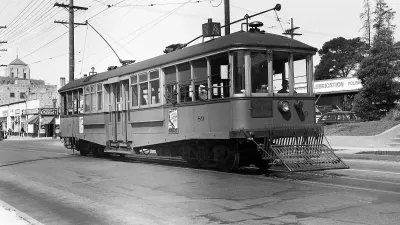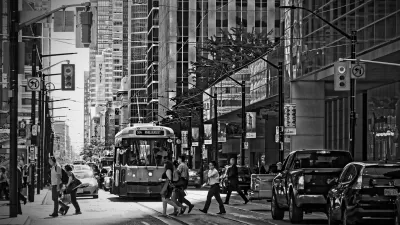A Toronto professor pushes against Christian Wolmar's assertion that the tram's demise can be connected to anti-worker policy. For one thing, trams never went away in some cities.

The history behind the gutting of public transit during the 20th century has been hotly debated. In a recent piece for The Guardian, Christian Wolmar argues that class snobbery contributed to anti-transit policy, with the middling classes preferring the more stately private automobile. Thomas R. Klassen doesn't entirely agree. "[Wolmar] argues that trams were eliminated 'because they catered for the working classes.' But surely that is too simplistic."
Klassen notes that cars quickly became working class transport. "As important in explaining public transit policies is that employment and residence patterns altered dramatically after the second world war. Moreover car ownership – for a while – became the nearly realised dream of many working-class households. In the 1950s and 60s it really did seem that public transportation, with the exceptions of subways and inter-city trains, largely would fade away."
In places like Toronto and Melbourne, trams survived the trend away from transit. "Toronto's trams have survived and prospered for two reasons. The first is that public-transit policymaking in Toronto was, and continues to be, so muddled and slow that politicians never got around to eliminating streetcars." The other, Klassen suggests, is simple good branding.
It's also important to remember that in places with a rising middle class, notably China, people prize both transit and car ownership. Driving has more cachet, but we have yet to see any of North America's historical transit-phobia.
FULL STORY: Thriving tram networks in Toronto and Melbourne

Planetizen Federal Action Tracker
A weekly monitor of how Trump’s orders and actions are impacting planners and planning in America.

The Simple Legislative Tool Transforming Vacant Downtowns
In California, Michigan and Georgia, an easy win is bringing dollars — and delight — back to city centers.

San Francisco's School District Spent $105M To Build Affordable Housing for Teachers — And That's Just the Beginning
SFUSD joins a growing list of school districts using their land holdings to address housing affordability challenges faced by their own employees.

In More Metros Than You’d Think, Suburbs are Now More Expensive Than the City
If you're moving to the burbs to save on square footage, data shows you should think again.

The States Losing Rural Delivery Rooms at an Alarming Pace
In some states, as few as 9% of rural hospitals still deliver babies. As a result, rising pre-term births, no adequate pre-term care and "harrowing" close calls are a growing reality.

The Small South Asian Republic Going all in on EVs
Thanks to one simple policy change less than five years ago, 65% of new cars in this Himalayan country are now electric.
Urban Design for Planners 1: Software Tools
This six-course series explores essential urban design concepts using open source software and equips planners with the tools they need to participate fully in the urban design process.
Planning for Universal Design
Learn the tools for implementing Universal Design in planning regulations.
Smith Gee Studio
City of Charlotte
City of Camden Redevelopment Agency
City of Astoria
Transportation Research & Education Center (TREC) at Portland State University
US High Speed Rail Association
City of Camden Redevelopment Agency
Municipality of Princeton (NJ)




























